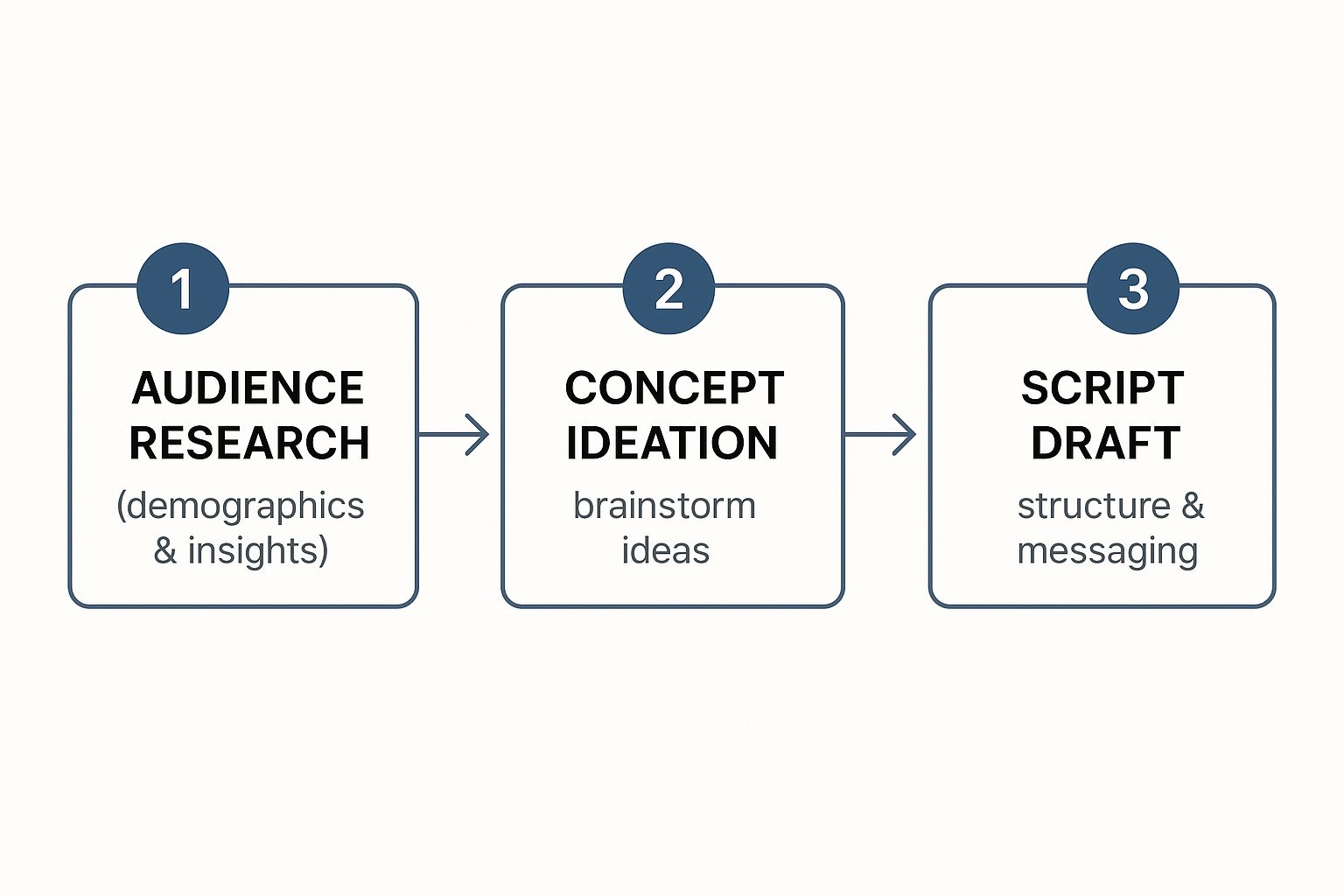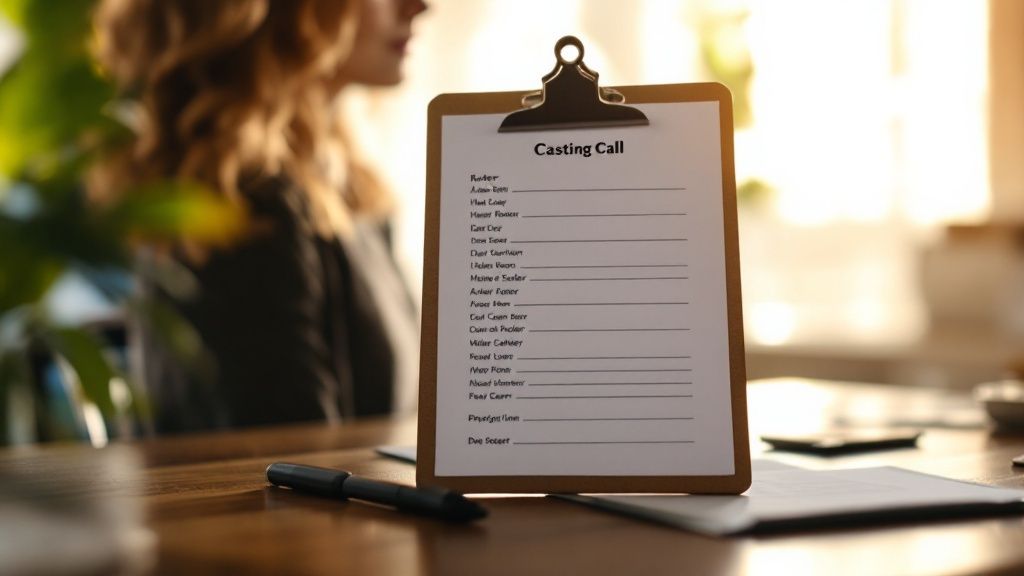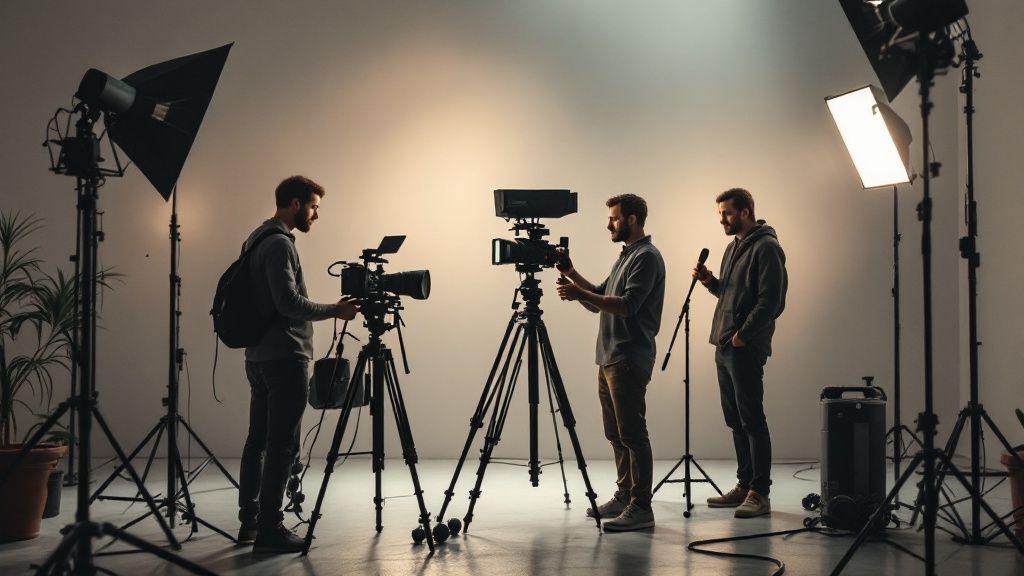
Meta Description: Learn how to make a commercial that drives results with our step-by-step guide. From strategy and scripting to production and distribution, we cover everything you need.
So you need to make a commercial. You've got a great product or service, but the thought of scripting, shooting, and launching an ad feels overwhelming. Many marketers and creators struggle with cutting through the digital noise, spending time and money on commercials that ultimately fall flat and fail to connect with their target audience. This guide provides a clear, actionable roadmap to navigate the entire process. We’ll break down how to build a solid strategy, craft a compelling narrative, and ensure your final product gets seen by the right people, turning your vision into a commercial that actually converts.
Step 1: Define Your Commercial's Core Strategy
Before you even think about cameras or scripts, a winning commercial starts with a rock-solid strategy. A great ad isn't just a cool idea; it's a tool built to achieve a specific business goal. Getting brutally honest about what you want to accomplish will guide every single decision you make. This pre-production phase is arguably the most critical step in learning how to make a commercial that delivers a real return on investment.
So, what's the one thing this ad absolutely must do? "Get more customers" is too vague. You need to be specific.
Pinpointing Your Primary Objective
Every commercial needs one clear, primary goal. Trying to do too much results in a muddled message that confuses potential customers. Most objectives fall into one of these buckets:
- Boost Brand Awareness: Introduce your brand to new audiences or become more recognizable. Success here is measured by reach, impressions, and brand recall.
- Generate Qualified Leads: Get contact information from people genuinely interested in your offer. Think form submissions, newsletter sign-ups, or demo requests.
- Drive Direct Sales: The goal is immediate revenue. You'll track conversion rates, average order value (AOV), and return on ad spend (ROAS) to measure success.
Nailing down your primary goal makes the creative process easier and gives you a concrete way to measure if your investment paid off.
Commercial Goal and KPI Alignment
| Primary Goal | Key Performance Indicator (KPI) | Example Metric |
|---|---|---|
| Brand Awareness | Engagement & Reach | Video Views, Social Shares |
| Lead Generation | Conversion Rate | Form Completions, Downloads |
| Direct Sales | Return on Ad Spend (ROAS) | Sales Revenue, Order Value |
Understanding Your Audience Deeply
Once you know what you want to do, you need to figure out who you're talking to. A detailed audience persona is your most valuable asset here. Forget basic demographics; dig deeper into their pain points, aspirations, and online behaviors. For example, a marketing agency targeting SaaS startups won't use the same tone or visuals as a brand selling directly to millennial parents. Knowing this informs everything from the script's tone to the choice of music. A great commercial doesn't just sell a product; it speaks to a specific person's problem or emotion.

Step 2: Craft a Narrative That Connects
With your strategy set, it's time to get creative. This is where you turn your core objective into a story that makes people feel something. A great commercial is a bite-sized story, and a powerful narrative is what separates a forgettable ad from one that drives action.

First, decide on a creative angle that fits your brand. A problem/solution format is a classic for a reason—it's clear and effective. Testimonials build trust instantly by letting a real customer tell the story. Or, you can tap into universal feelings like joy or nostalgia with an emotional narrative. The best approach circles back to your brand's personality and the audience you identified. If you're stuck, using some of the best AI tools for content creation can help you brainstorm initial concepts and script ideas.
The Anatomy of a Powerful Script
Every solid commercial script has three non-negotiable parts:
- The Hook (0-3 Seconds): You have a blink-and-you'll-miss-it window. Grab attention with a surprising question, a stunning visual, or a relatable problem that makes them stop scrolling.
- The Body (Concise Delivery): Deliver your core message. Don't cram in every feature. What’s the one thing you need them to remember?
- The Call to Action (CTA): End with a clear command. "Visit our website," "Download the app," "Shop the sale." A vague ending wastes the connection you just built.
Read your script out loud. If it sounds clunky or unnatural, it will sound even worse on screen. Sharpening your writing with some foundational copywriting tips for beginners can make a huge difference.
Visualizing Every Scene with a Storyboard
A storyboard is the blueprint for your commercial, translating your script into a visual plan, shot by shot. This step is non-negotiable for aligning your creative team and spotting production issues before they become expensive problems on set. Don't worry about being an artist—stick figures are fine. The goal is to create a shared vision. While visuals are key, don't forget audio. Understanding the art of sound design is what separates an amateur commercial from a professional one, adding layers of emotion and polish.
Step 3: Bring Your Vision to Life in Production
This is where your scripts and storyboards become real footage. A smooth production phase is all about solid preparation. Whether you're working with a professional crew or a small internal team, having a clear plan ensures you capture everything you need efficiently.

Assembling Your Cast, Crew, and Location
The people on set—both in front of and behind the camera—will make or break your commercial. A seasoned actor can deliver a line perfectly, while a real customer can provide unmatched authenticity. The choice depends on your creative direction. Your location is also a character in the story; a sleek office says "professional," while a cozy home suggests comfort. Just as important is your gear. Viewers will forgive slightly grainy video, but they will bounce the second they hear terrible audio. Invest in good microphones and lighting to ensure a professional look and feel.
A Checklist for a Smooth Shoot Day
Shoot day is an organized whirlwind. A production checklist is your best friend for staying on schedule and on budget.
- Finalized Shot List: Go deeper than your storyboard. List every shot with details on camera angle, movement, and lens choice.
- Detailed Call Sheet: A master document telling everyone—cast, crew, clients—where to be and when, with contact info for key people.
- Capture Plenty of B-Roll: You will always need more extra footage (close-ups, wide shots, alternate angles) than you think you do for the edit.
- Props and Wardrobe: Have everything organized and ready to go to avoid delays that throw the entire day off schedule.
This detailed planning turns potential chaos into a controlled, creative process, ensuring you have all the pieces for a killer commercial.
Step 4: Polish Your Story in Post-Production
The cameras have stopped rolling, but your commercial is far from finished. Post-production is where you shape raw footage into a polished, persuasive ad. This is where the magic happens—where editing, sound, and color breathe life into the story.
It starts with organization. Label all your clips, sound files, and graphics meticulously in your editing software to streamline the creative process.
Assembling the Narrative and Adding Polish
First, build a "rough cut" by piecing the best takes together according to your storyboard. The goal is simply to get the basic narrative flow in place. From there, you'll refine the pacing, making precise cuts to dial up the energy or create an emotional mood. Once the picture edit is locked, you'll add the finishing touches:
- Sound Design: The right music is a shortcut to emotion. Sound effects (SFX) make the world feel immersive. Finally, audio mixing ensures dialogue, music, and SFX are perfectly balanced.
- Color Grading: Adjust the colors to create a specific look and feel that aligns with your Brand Strategy. You can make visuals pop with vibrant colors or go for a moody, cinematic tone.
- Graphics and CTA: Add text overlays, your company logo, and a clear, compelling call to action (CTA). This is the final prompt that tells viewers exactly what to do next.
👉 Try MediaWorkbench.ai for free – schedule your posts and generate AI content in one place!
Step 5: Distribute and Analyze Your Commercial
You've created a brilliant commercial. Now, you need to get it in front of the right people. A great ad is worthless if your target audience never sees it. Your distribution strategy should tie directly back to the audience persona you built at the very beginning. Where do they spend their time?

- Broadcast & Connected TV (CTV): A powerhouse for reaching broad audiences, with CTV offering the targeting capabilities of digital ads.
- YouTube: Perfect for pre-roll, mid-roll, or in-display ads where you can capture an engaged viewer.
- Social Media (Instagram, TikTok, Facebook): Unbeatable for reaching hyper-specific demographics with short, punchy, vertical content.
The biggest mistake is a one-size-fits-all approach. A horizontal TV spot looks clunky in a vertical Instagram Story. Create multiple cuts optimized for each platform: a 15-second vertical version for TikTok, a 6-second bumper for YouTube, and the full 30-second ad for CTV.
Launching, Watching, and Tweaking Your Campaign
Once the campaign is live, the job isn't done. Monitor performance against the KPIs you set in the planning stage, keeping a close eye on metrics like:
- View-Through Rate (VTR): How many people watched your ad to completion?
- Click-Through Rate (CTR): What percentage of viewers clicked your call to action?
- Conversion Rate: How many clicks turned into a sale or lead?
Use this data to optimize your campaigns on the fly by adjusting targeting, ad copy, or budget allocation. To make your campaigns work even smarter, explore these marketing automation best practices.
Conclusion
Learning how to make a commercial that works boils down to a clear, five-step process: strategize, script, produce, polish, and distribute. By starting with a specific goal and a deep understanding of your audience, you create a foundation for a story that genuinely connects. A well-planned production and a meticulous post-production phase will bring that story to life, while a smart distribution strategy ensures it reaches the right people on the right platforms. Don't just create an ad—craft a strategic tool designed to achieve measurable results for your business.
Ready to streamline your entire creative workflow? From generating script ideas to crafting social media copy for your launch, Media Workbench provides the tools you need in one place. Explore how our AI-powered platform can save you hours of work.

